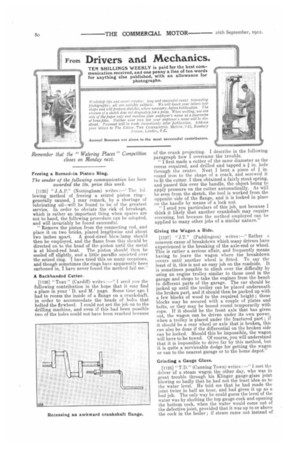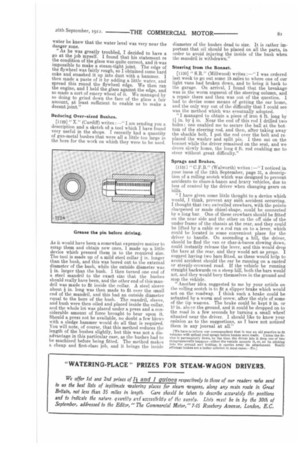From
Page 20

Page 21

If you've noticed an error in this article please click here to report it so we can fix it.
Drivers and Mechanics.
TEN SHILLINGS WEEKLY is paid for the best communication received, and one penny a line of ten words for anything else published, with an allowance for photographs.
Freeing a Burned-in Pistoa Ring.
The sender of the following communication has been awarded the we. prize this week.
[1125] " J .A.P." (Nottingham) writes:—" The following method of freeing a seized piston ring— generally caused, I may remark, by a shortage of lubricating oil—will be found to be of the greatest service. In order to obviate the risk of breakage, which is rather an important thing when spares are not to hand, the following procedure can be adopted, and will invariably be found successful. "Remove the piston from the connecting rod, and place it on two bricks, placed lengthwise and about two inches apart. A good-sized blow-lamp should then be employed, and the flame from this should be directed on to the head of the piston until the metal is at blood-red heat. The piston should then be cooled off slightly, and a little paraffin squirted over the seized ring. I have tried this on many occasions, and though sometimes the rings have apparently been carboned in, I have never found the method fail me."
A Backhanded Cutter.
[11261 "Tony "(Cardiff) writes I send you the following contribution in the hope that it may find a place in your 'D. and M.' page. Some time ago I had to recess the inside of a flange on a crankshaft, in order to accommodate the heads of bolts that bolted the flywheel. I could not get the job on to the drilling machine, and even if this had been possible two of the holes could not have been reached because of the crank projecting. I describe in the following paragraph how I overcame the trouble. "I first made a cutter of the same diameter as the recess required, and drilled and tapped a in. hole through the centre. Next I bent a piece of j in. round iron to the shape of a crank, and screwed it to fit the cutter. I then obtained a fairly stout spring, and passed this over the handle, the object being to apply pressure on the cutter automatically. As will be seen from the sketch, the tool is worked from the opposite side of the flange, and it is locked in place on the handle by means of a lock nut.
"I send you particulars of this job, not because I think it likely that another crankshaft may require recessing, but because the method employed can be applied to many other jobs of a similar nature."
Giving the Wagon a Ride.
[1127] " J.T." (Paddington) writes:—" Rather a common cause of breakdown which many drivers have experienced is the breaking of the axle-end or wheel. This is rather a serious affair, and frequently means having to leave the wagon where the breakdown occurs until another wheel is fitted. To say the least of it, this is not an easy job on the roadside. It is sometimes possible to climb over the difficulty by using an engine trolley similar to those used in the garage and shops to take the engines from the bench to different parts of the garage. The car should be jacked up until the trolley can be placed underneath the broken part, and it should then be packed up with a few blocks of wood to the required height ; these blocks may be secured with a couple of plates and bolts, or they may be bound round temporarily with rope. If it should be the front axle that has given out, the wagon can be driven under its own power, when a trolley is placed under the fractured part ; if it should be a rear wheel or axle that is broke; this can also be done if the differential on the broken side can be locked. Should this be impossible, the wagon will have to be towed. Of course, you will understand that it is impossible to drive far by this method, but it is quite a serviceable dodge for getting the wagon or van to the nearest garage or to the home depot."
Grinding a Gauge Glass.
(1128] " T.D." (Canning Town) writes :—" I met the driver of a steam wagon the other day, who was in great trouble through his Klinger gauge-glass joint blowing so badly that he had not the least idea as to the water level. He told me that he had made the joint twice in half an hour, and had given it up as a bad job. The only way he could guess the level of the water was by shutting the top gauge-cock and opening the bottom cock, when the water would come out of the defective joint, provided that it was up to or above the cock in the boiler ; if steam came out instead of
water he knew that the water level was very near the danger zone.
"As he was greatly troubled, I decided to have a go at the job myself. I found that his statement re the condition of the glass was quite correct, and it was impossible to make a steam-tight joint. The edge of the flywheel was fairly rough, so I obtained some hard coke and smashed it up into dust with a hammer. I then made a pa,ste of it by adding a little water, and spread this round the flywheel edge. We then ran the engine, and I held the glass against the edge, and so made a sort of emery wheel of it. We managed by so doing to grind down the face of the glass a fair amount, at least sufficient to enable us to make a decent joint."
Reducing Over-sized Bushes.
[1129] "X." (Cardiff) writes :—" I am sending you a description and a sketch of a tool which I have found very useful in the shops. I recently had a quantity of gun-metal bushes that were all a little too large in the bore for the work on which they were to be used.
As it would have been a somewhat expensive matter to scrap them and obtain new ones, I made up a little device which pressed them in to the required size. The tool is made up of a mild steel collar 1. in. longer than the bush, and this was bored out to the external diameter of the bush, while the outside diameter was in. larger than the bush. I then turned one end of a steel mandril to the exact size that the bushes should really have been, and the other end of this mandril was made to fit inside the collar. A steel sleeve about 4 in. long was then made to fit over the small end of the mandril, and this had an outside diameter equal to the bore of the bush. The mandril, sleeve, and bush were then oiled and placed inside the collar. and the whole lot was placed under a press and a considerable amount of force brought to bear upon it. Should a press not be available, no doubt a few blows with a sledge hammer would do all that is required. You will note, of course, that this method reduces the length of the bushes slightly, but this was not a disadvantage in this particular case, as the bushes had to be machined before being fitted. The method makes a cheap and first-class job, and it brings the inside
diameter of the bushes dead to size. It is rather important that oil should be placed on all the parts, in order to avoid injuring the inside of the bush when. the mandril is withdrawn."
Steering front the Bonnet.
[1130] " S.R." (Millwood) writes :—" I was ordered last week to go out some 15 miles to where one of our light vans had broken down, and to bring it back to the garage. On arrival, I found that the breakage was in the worm segment of the steering column, and a. repair there and then was out of the question. I had to devise some means of getting the car home, and the only way out of the difficulty that I could see was the method which was eventually adopted.
"I managed to obtain a piece of iron 6 ft. long by I/ in. by 4 in. Near the end of this rod I drilled two holes : one enabled me to secure the ball at the bottom of the steering rod, and then, after taking away the shackle bolt, I put the rod over the bolt and re• placed the washer and split pin. I then sat on the bonnet while the driver remained on the seat, and we drove slowly home, the long 6 ft. rod enabling me to steer without great difficulty."
Sprags and Brakes.
[1131] " C.F. B." (Walworth) writes :—" I noticed in your issue of the 121h September, page 31, a description of a rolling scotch which was designed to prevent accidents to chars-h-bancs and heavy vehicles, due to loss of control by the driver when changing gears on hills.
"I have given some little thought to a device which would, I think, prevent any subh accident occurring. I thought that two swivelled crowbars, with the points sharpened or made chisel-shape, could be connected by a long bar. One of these crowbars should be fitted on the near side and the other on the off side of the under frame of the chassis at the rear, and they could he lifted by a cable or a. rod run on to a lever, which could be located in some convenient place for the driver to handle. On ascending a hill, the driver, should he find the van or char-h-bancs slowing down, could instantly release the lever, and this would drop the bars at the rear, and they would act as props. I suggest having two bars fitted, as these would help to avoid accident should the car be running on a canted or steeply-crowned road. If the vehicle be running straight backwards on a steep hill, both the bars would act, and they would bury themselves in the ground and stop the vehicle. "Another idea suggested to me by your article on the rolling scotch is to fit a slipper brake which would act on the roadway. I think such a brake could be actuated by a worm and screw, after the style of some of the tip wagons. The brake could be kept 9 in. or 10 in. above the ground, and it could be dropped on to the road in a few seconds by turning a small wheel situated near the driver. I should like to know your opinion as to the suggestions, as I have not noticed them in any journal at all."
[WIS base to inform nor correspondent that it was an old practice to fit vehicles with spiked road sprags before brakes were made. Unless the device is permanently down, by the Ono the driver lets it drop one of two things.general]y happens—either the vehicle mounts it, or, on its sticking into the ground and holding, it carries away its attachment. Really efficient brakes are a better solution in most cases.—En.]






















